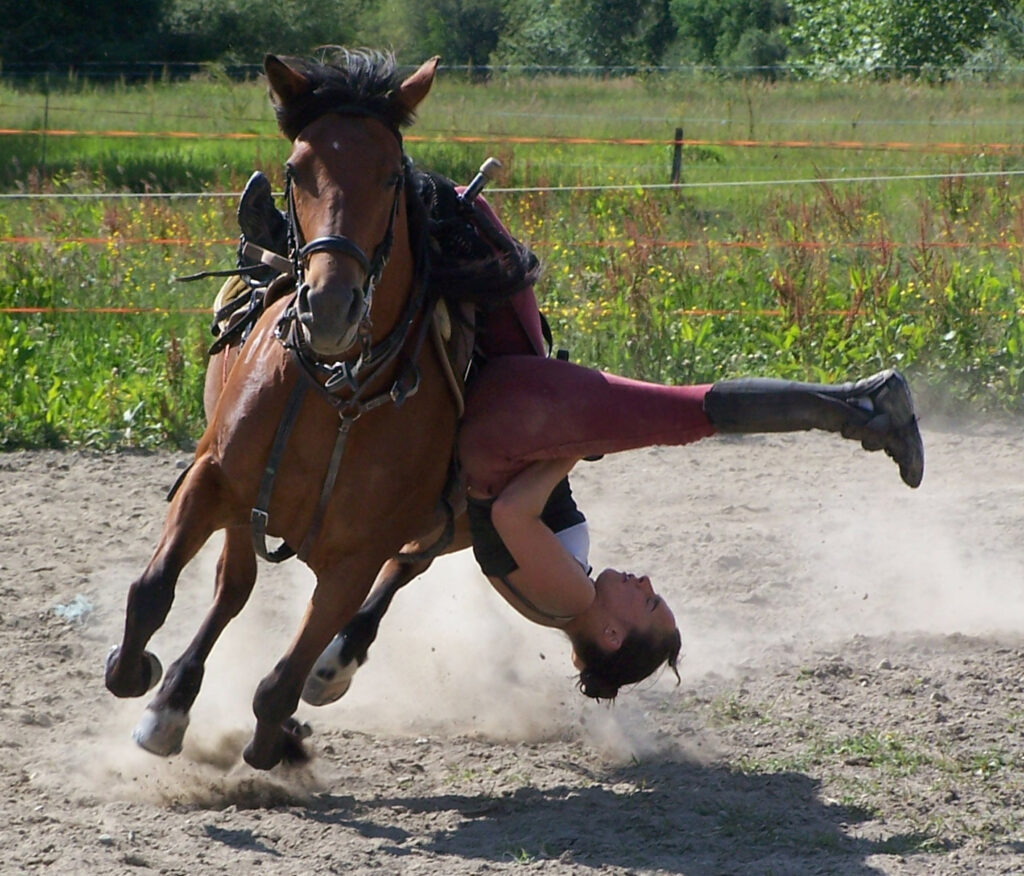Equestrian sport, acrobatics can also be qualified as an artistic and acrobatic discipline. Two types of acrobatics exist: circle acrobatics and straight line acrobatics, each requiring different equipment and horses.

The acrobatics in circle
It is inspired by both military practices based on saddle exercises and circus art. Combining the notions of aesthetics, risk-taking, balance and sliding, acrobatics requires gymnastic training based on flexibility and muscle building exercises. Three axes of work are essential: the work of the horse, mounted or on foot, the work of the acrobat, gymnast, and dancer and, finally, the common work of the trio horse-acrobat-dancer. Even when practiced individually, acrobatics remains a team sport: beyond the acrobat himself, we must not forget the person holding the rope, who is responsible for controlling the horse, its pace, its rhythm, its circle.
The vaulting horse in circle
He must have a solid back, long and flat, quality hocks, a good neck, a good eye.
He must be gentle, not ticklish, and not vicious. His gait must be supple, light, and regular. His gallop must be particularly comfortable. The most common breeds in this discipline are the French-Saddle and the Hanoverian. The size can vary according to the age of the acrobat and the category, team or individual, from 1,40 m to 1,80 m at the withers.
The equipment of acrobatics on horseback
The horse is harnessed with a simple snaffle, equipped with a bit with olives with washers, attached to the surfaix by two fixed side reins each with a rubber ring. Sliding reins, called “German”, with a loop at each end, can be used instead of fixed reins at the beginning of work sessions or specific training. A lead rein allows the person holding the rope to keep the horse in a regular circle of about 7 m radius.
The person holding the rope regulates the gait with the help of the chambriere, which consists of a white fiberglass handle (usually telescopic) 3 m long and a natural leather bit 4.50 m long. The surfaix has two rigid handles on the top and a retractable soft handle on each side. It is placed on a slightly larger foam pad, which is positioned in front of a mat that is one meter long, 90 cm wide and up to 3 cm thick, including the cover. It is advisable to protect the horse’s limbs with bands and to equip its front hooves with bells.
The acrobat is dressed in a tight-fitting outfit called leotard or academic, made of lycra or other elastic fibers; he wears leather acrobatic shoes with a grooved plastic sole.
Imposed and free figures in acrobatics on horseback
Six compulsory figures are defined at the international level: the basic position (including the entry), the standard, the mill, the scissors, the standing, the amazon (including an external facial exit).
In the individual event, a downstroke must be added between the mill and the scissors. The basic position is a sitting with arms in a cross; the standard is a kneeling position with the left arm and the right leg raised (circle in the left hand); the mill is the turn of the horse by successive passages of leg in cadence; the scissors is a sequence of a forward swing with a backward turn and a backward swing with a forward turn; the standing is a static position of 4 beats (4 gallop strides) standing with arms crossed; finally, the amazon is a dynamic sequence of a forward swing to an inside amazon position followed by an outside facial dismount (swing and passage over the croup).
A vaulting performance consists of a compulsory program and a free program performed to music. The free program lasts one minute for individuals and five minutes for teams. Four marks are awarded for composition, execution, difficulty, and general impression. The last one considers for 90 % the quality of the horse’s gallop. The difficulty score is used to evaluate risk-taking and acrobatics. In individual, the program must include static and dynamic figures: on the ground on horseback, passages on the neck, on the back, on the side, head down, front face, back face. The free figures by team are carried out by 1 to 3 acrobats simultaneously, thus allowing carries. The variety of the orientations of the figures, the entries and exits of the eight acrobats of the team, their regular and harmonious passages, the originality, the emotion, the musical interpretation, and the aesthetics are considered in the note of composition.
The straight line acrobatics
The acrobatic riders wearing boots ride small, fast horses. These are harnessed with a special saddle called “Cossack”, made of cushions, a vertical pommel, and various straps. The exercises are carried out on a straight line of at least 60 m. The horse is launched on a fast gallop which allows him to balance despite the sometimes destabilizing movements of his rider, on the side. Little developed in competition, the straight line acrobatics is mostly practiced in the framework of shows or film shootings and by professionals like stuntmen.
For more information: presentation of acrobatics


